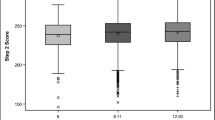Abstract
Purpose
The University of Arizona College of Medicine underwent several curricular revisions that began in 2006. These changes included (1) moving from a traditional to a systems-based curriculum, (2) adding a second campus location, and (3) altering the duration of clinical clerkships. We examined whether these curricular revisions impacted student performance on the United States Medical Licensing Examination (USMLE) step 1 and step 2 Clinical Knowledge (CK) examinations.
Method
We examined curricular changes that took place from academic years 2006–2010 (classes of 2010–2014) compared to the previous traditional-based curriculum in two different medical school tracks under one university system. Academic years 2002–2005 served as control, and ten different curricular groups were examined. An ANOVA was conducted for each step exam, and all pairwise differences were examined using Tukey’s honest significant differences. Statistical significance was established at p < 0.05.
Results
The first year of the revised preclerkship curriculum resulted in lower step 1 scores compared to the previously traditional curriculum. However, statistically significant mean increases in step 1 and 2 scores were found for curricular groups that experienced the revised preclerkship curriculum, a return to six-week clerkship rotations, and had completed all 4 years at one specific campus on one specific medical track.
Conclusion
With the integration of basic and clinical sciences in the first 2 years and modifications to the clerkship rotations, the content of the curriculum was taught with more regard to what will ultimately benefit the practicing physician. This curricular reform led to higher scores particularly on the step 2 USMLE exam.



Similar content being viewed by others
References
American Medical Association, Accelerating change in medical education. Available at: (http://www.ama-assn.org/ama/pub/about-ama/strategic-focus/accelerating-change-in-medical-education.page?). Accessed December 15th, 2014.
Innovation is sweeping through U.S. Medical Schools. The wall street journal http://www.wsj.com/articles/innovation-is-sweeping-through-u-s-medical-schools-1424145650. Accessed 20 May 2015.
Joiner KA, Schloss EP, Malan P, Flynn SD, Chadwick JA. Phoenix rises, with Tucson’s help: establishing the first four-year allopathic program in the nation’s fifth largest city. Acad Med. 2007;82(12):1126–38.
Chadwick JA, Moynahan KF, Koff NA. University of Arizona College of Medicine: Tucson and Phoenix. Acad Med. 2010;85(9):S78–83.
Williams PC, Epps AC, McCammon S. The strategic impact of a changing curriculum and learning environment on medical students’ academic performance. J Natl Med Assoc. 2011;103:802–10.
Rosenthal RH, Levine RE, Carlson DL, Clegg KA, Crosby RD. The “shrinking” clerkship: characteristics and length of clerkships in psychiatry undergraduate education. Acad Psychiatry. 2005;29910:47–51.
Ling Y, Swanson DB, Hotzman K, Bucak SD. Retention of basic science information by senior medical students. Acad Med. 2008;83(10):582–5.
Hecker K, Violato C. How much do differences in medical schools influence student performance? A longitudinal study employing hierarchical linear modeling. Teaching and Learning in Medicine: An International Journal. 2008;20(2):04–113.
Montgomery DC. Design and analysis of experiments. Sixth ed. Hoboken: Wiley; 2005.
Acknowledgements
This study was funded in part with a grant from the Department of Academic Affairs, University of Arizona College of Medicine – Phoenix. The authors wish to thank Dr. Jacquelyn Chadwick and Dr. Christine Savi for their help and support.
Author information
Authors and Affiliations
Corresponding author
Ethics declarations
The University of Arizona (UA) College of Medicine (COM) Institutional Review Board approved this study.
Ethical Approval
All procedures performed in studies involving human participants were in accordance with the ethical standards of the institutional and/or national research committee and with the 1964 Helsinki Declaration and its later amendments or comparable ethical standards.
For this type of study formal consent is not required.
Rights and permissions
About this article
Cite this article
Lundy, M.B., Standley, C.A. & Westveld, A.H. Curricular Reform in Two Medical School Tracks and the Impact on USMLE Scores. Med.Sci.Educ. 27, 201–207 (2017). https://doi.org/10.1007/s40670-016-0368-y
Published:
Issue Date:
DOI: https://doi.org/10.1007/s40670-016-0368-y




